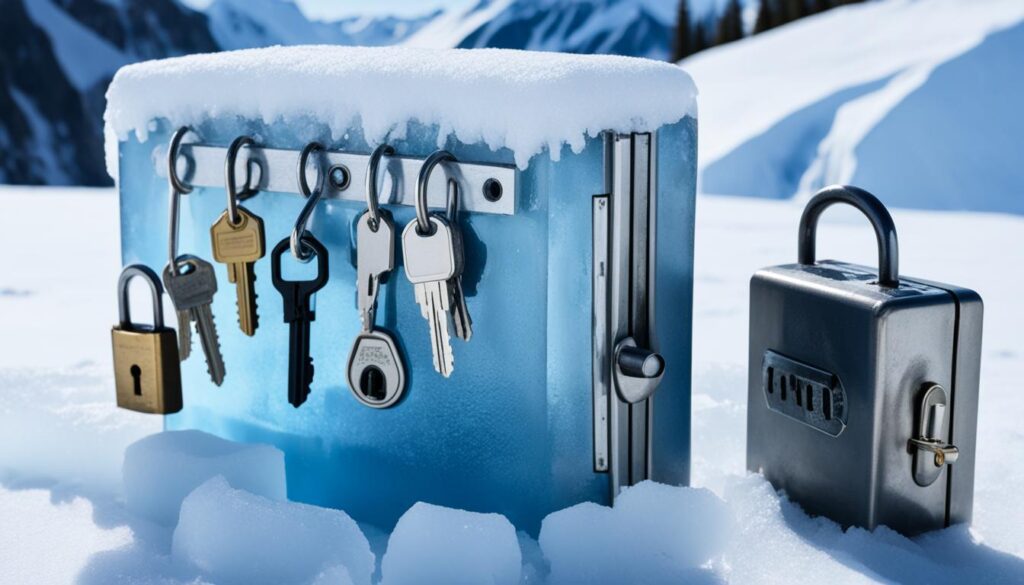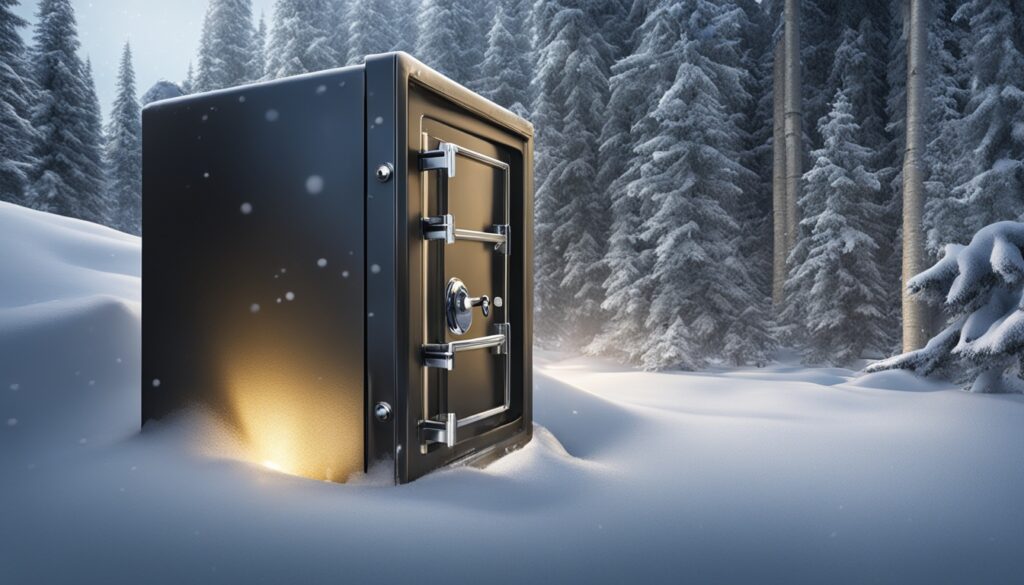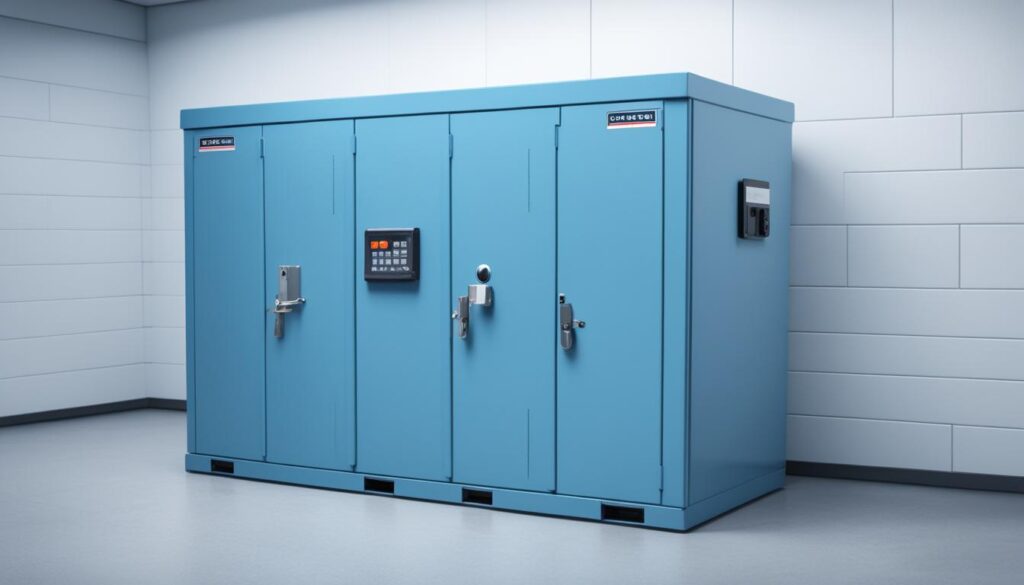In the dynamic world of cryptocurrency and blockchain technology, the concept of cold storage has emerged as a critical strategy for securing digital assets. Cold storage refers to the practice of keeping cryptocurrency funds offline, stored in a secure hardware device or other physical medium, to protect them from cyber threats such as hacking or malware.
The core principle of cold storage is to remove the private keys required to access your cryptocurrency from any internet-connected device. Reducing the risk of theft or unauthorized access. This approach has become increasingly important in the cryptocurrency space. As it allows users to take self-custody of their digital assets and enhance the overall security of their holdings.
Key Takeaways
- Cold storage refers to the practice of storing cryptocurrency private keys offline to protect against online threats.
- It involves removing the private keys from any internet-connected device, significantly reducing the risk of hacking, malware, or other cyber attacks.
- Cold storage has become an essential tool for cryptocurrency users looking to take self-custody of their digital assets and enhance the security of their holdings.
- There are various cold storage methods, including hardware wallets, paper wallets, and other secure physical storage solutions.
- The primary benefit of cold storage is the increased security it provides. Protecting your cryptocurrency from online threats and risks associated with hot wallets or online exchanges.
Understanding Cryptocurrency Wallets
Cryptocurrency wallets are the fundamental tools used to access, manage, and secure digital assets. These wallets store the public and private keys necessary for interacting with the blockchain and authorizing transactions. The public key, often compared to an email address, allows others to send cryptocurrency to your wallet. While the private key is the unique digital signature required to access and spend your funds.
Public and Private Keys
The public key is the visible, shareable address that enables others to deposit cryptocurrency into your wallet. It serves as the public-facing identifier for your wallet, much like an email address. In contrast, the private key is the secret code that grants you exclusive access to your digital assets. This private key must be kept secure, as anyone who gains access to it can potentially steal your cryptocurrency.
Hot vs. Cold Wallets
Cryptocurrency wallets can be broadly categorized as hot wallets or cold wallets, each with its own advantages and trade-offs. Hot wallets are connected to the internet, providing convenient access to your cryptocurrency but exposing them to potential online threats like hacking and malware. Cold wallets, on the other hand, are stored offline. Reducing the risk of theft or unauthorized access, but are less convenient for frequent transactions.

Understanding the differences between hot and cold wallets is crucial for cryptocurrency users looking to strike the right balance between security and accessibility when managing their digital assets.
What is Cold Storage?
Cold storage refers to the practice of storing cryptocurrency private keys and holdings in an offline, physical medium to protect them from online threats. This can involve using hardware wallets, paper wallets, or other secure storage methods that are not connected to the internet. The goal of cold storage is to remove the private keys from any internet-connected device, significantly reducing the risk of hacking, malware. Or other cyber attacks that could compromise your digital assets.
By storing your cryptocurrency private keys in an offline environment, cold storage provides an extra layer of security compared to online or hot wallet storage methods. This physical separation from the internet greatly minimizes the potential for unauthorized access or theft. Making it a crucial strategy for offline cryptocurrency storage and physical cryptocurrency storage.

The key benefit of cold storage is that it removes the private keys required to access your cryptocurrency from any internet-connected device, drastically reducing the risk of hacking or malware-based attacks. This makes cold storage an essential tool for cryptocurrency users looking to take full control and self-custody of their digital assets.
Types of Cold Storage Methods
When it comes to securing your cryptocurrency, there are several distinct cold storage methods to consider. From the classic paper wallets to the more advanced hardware wallets and sound wallets. Each approach offers its own unique benefits and tradeoffs in terms of security and convenience.
Paper Wallets
One of the most basic yet effective forms of cold storage is the trusty paper wallet. This method involves physically printing or writing down your private keys and public addresses on a piece of paper. Which is then kept in a secure location offline. Paper wallets provide an extremely secure way to store your cryptocurrency. As the private keys never touch any internet-connected device, reducing the risk of theft or hacking.
Hardware Wallets
Hardware wallets are specialized physical devices designed specifically for the secure storage of cryptocurrency private keys. These wallets, such as Trezor and Ledger, store your keys offline and require a physical interaction. Like pressing a button, to authorize transactions. This added layer of security makes hardware wallets one of the most popular and trusted cold storage solutions for cryptocurrency holders.
Sound Wallets
Another innovative cold storage method is the sound wallet, which uses audio recordings to store encrypted private keys. By converting your private keys into an audio file. You can then store this file on a physical medium like a CD or USB drive, keeping your cryptocurrency safe from online threats. Sound wallets offer a unique approach to cold storage that can be more convenient than traditional paper or hardware-based solutions.
Deep Cold Storage
For those seeking the ultimate in cold storage security, deep cold storage solutions exist. This can involve burying hardware wallets in secure, remote locations or using third-party storage vaults to physically safeguard your cryptocurrency. While these methods may be the most secure. They often come with significant inconveniences, such as limited access and the need for specialized infrastructure.

Each of these cold storage methods has its own advantages and drawbacks, offering varying levels of security and accessibility. The most appropriate solution will depend on your individual needs, risk tolerance, and the value of your cryptocurrency holdings. By understanding the nuances of these different cold storage approaches, you can make an informed decision on the best way to safeguard your digital assets.
Benefits of Cold Storage
The primary benefit of using cold storage for cryptocurrency is the enhanced security it provides. By removing private keys from any internet-connected device, cold storage greatly reduces the risk of hacking, malware, and other online threats that could compromise your digital assets. Cold storage also protects your funds from risks associated with online wallets and exchanges, such as data breaches, insider theft, or platform failures. Overall, the offline nature of cold storage provides a much higher level of protection from online threats for your cryptocurrency compared to hot wallets or online storage methods.
Increased Security
One of the key advantages of cold storage is the increased security it offers for your cryptocurrency holdings. By storing your private keys offline, in a physical medium like a hardware wallet or paper wallet. You effectively eliminate the risk of your funds being accessed or stolen through online attacks. This security of cold storage is crucial for protecting your digital assets from the constant threat of hacking, malware, and other cyber threats that plague the digital landscape.
Protection from Online Threats
In addition to enhancing the overall security of your cryptocurrency, cold storage also provides an important layer of protection against the various online threats that can compromise your digital assets. Unlike hot wallets that are connected to the internet, cold storage methods remove your private keys from any internet-connected devices, drastically reducing the benefits of cold storage in terms of safeguarding your funds from unauthorized access or theft. This offline storage approach is an essential tool for cryptocurrency users seeking to prioritize the security and safekeeping of their digital wealth.

Setting Up Cold Storage
The process of setting up cold storage for your cryptocurrency holdings involves several crucial steps. The first and most important task is to generate a new set of private keys in an offline environment. Ensuring they are never exposed to potential online threats. These private keys are the gateway to your digital assets, so it’s essential to create them in a secure, disconnected setting.
Generating Private Keys
To generate your private keys, you can use a variety of methods, such as specialized hardware wallets or even pen and paper. The key is to never expose these sensitive codes to any internet-connected device. Once you have your private keys, you’ll need to print them out or transfer them to a physical storage medium, such as a hardware wallet or a paper wallet. This ensures that your private keys are stored offline and protected from cyber threats.
Printing or Transferring Keys
Depending on your preferred cold storage method, you can either print your private keys onto paper or transfer them to a hardware wallet. Printing paper wallets is a popular option, as it allows you to store your private keys in a physical format. That can be easily secured and kept in a safe location. Alternatively, transferring your private keys to a hardware wallet, such as a Trezor or a Ledger. Provides an extra layer of security by housing your keys on a dedicated offline device.
Adding Funds to Cold Storage
Once your cold storage setup is complete, you can begin adding funds to your offline storage. This is typically done by sending your cryptocurrency to the public address associated with your cold storage. This public address can be obtained from your hardware wallet, paper wallet, or other cold storage solution. By sending your funds to this offline address, you’re ensuring that your digital assets are protected from online threats and under your direct control.
Redeeming Coins from Cold Storage
When you need to access or use the cryptocurrency stored in your cold storage, you’ll need to redeem the coins by connecting your physical storage device to an online interface, such as a compatible cryptocurrency wallet or exchange. This process involves using your private keys to authorize the transaction. Allowing you to withdraw or transfer your funds as needed. It’s important to follow the specific instructions and security procedures for your chosen cold storage method to ensure a safe and successful redemption process.

Custodial vs. Non-Custodial Wallets
In the world of cryptocurrency, there is a fundamental distinction between custodial and non-custodial wallets. Custodial wallets are managed by a third-party service, which holds the private keys on the user’s behalf. This provides more convenience, but means the user must trust the third party to securely store and manage their funds.
Self-Custody and Control
In contrast, non-custodial wallets, such as those used for cold storage. Give the user full control and self-custody of their private keys and digital assets. While non-custodial wallets require more personal responsibility, they offer greater security and independence from third-party risks.
Trusting Third Parties
When using a custodial wallet, users must place their trust in the third-party service to safeguard their cryptocurrency holdings. This reliance on a third party can expose users to potential risks. Such as data breaches, platform failures, or even insider theft. In contrast, non-custodial wallets, like those used for cold storage. Allow users to take full responsibility for the security of their digital assets, reducing their dependence on third-party intermediaries.

Best Practices for Cold Storage
To ensure the long-term security of your cryptocurrency holdings stored in cold storage. It’s crucial to follow a set of best practices. This includes maintaining secure backups of your private keys or seed words. As well as implementing robust physical security measures to protect your cold storage devices.
Backup and Recovery
One of the most important best practices for cold storage is to maintain secure backups of your private keys or seed words. These backup copies should be stored in multiple physical locations. Such as a fireproof safe, a safety deposit box, or with a trusted third-party custodian. To ensure that your cryptocurrency can be recovered in the event of loss, damage, or theft of your primary cold storage device.
Additionally, it’s recommended to regularly test your backup procedures to ensure that the recovery process works as expected, and to update your backups whenever you make changes to your cold storage setup.
Physical Security Measures
To protect your cold storage devices from physical threats, such as damage, loss, or theft. It’s crucial to take appropriate physical security measures. This may include storing your cold storage devices in fireproof and waterproof containers. Keeping them in a secure location like a safe or a bank vault, and regularly checking on their condition.
Furthermore, it’s important to stay up-to-date with the latest hardware and software advancements in the cold storage space, and to use reputable, well-tested products to minimize the risk of vulnerabilities or malfunctions. That could compromise the security of your digital assets.

Conclusion – What is a cold storage for cryptocurrency?
In conclusion, cryptocurrency cold storage is a crucial technique for securely storing and protecting digital asset holdings. By removing private keys from any internet-connected devices. Cold storage greatly reduces the risk of hacking, malware, and other online threats that can compromise valuable digital assets. While cold storage methods may be less convenient than hot wallets. The enhanced security they provide makes them an essential tool for cryptocurrency users looking to take full control and self-custody of their digital wealth.
By understanding the different types of cold storage and following best practices for setup and maintenance. Crypto holders can ensure the long-term safety of their valuable cryptocurrency holdings. This includes implementing secure backup and recovery measures. As well as taking physical security precautions to protect their cold storage devices from loss, theft, or damage.
Ultimately, the adoption of cold storage techniques is a critical step in the journey to securing digital assets. Also empowering cryptocurrency users to take full control of their financial sovereignty. As the cryptocurrency ecosystem continues to evolve, the importance of cold storage will only grow. Making it an essential consideration for any crypto investor or enthusiast looking to safeguard their digital wealth.










